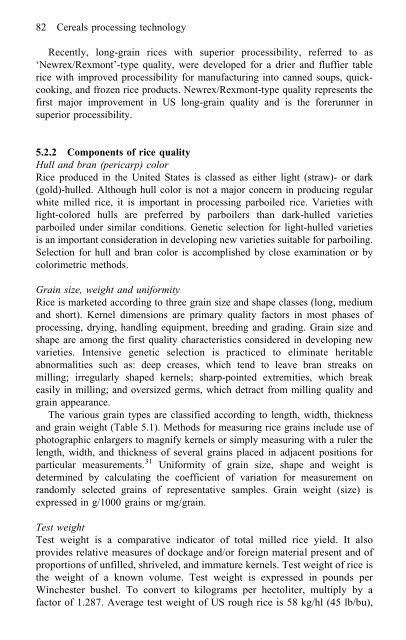Cereals processing technology
Cereals processing technology
Cereals processing technology
You also want an ePaper? Increase the reach of your titles
YUMPU automatically turns print PDFs into web optimized ePapers that Google loves.
82 <strong>Cereals</strong> <strong>processing</strong> <strong>technology</strong><br />
Recently, long-grain rices with superior processibility, referred to as<br />
‘Newrex/Rexmont’-type quality, were developed for a drier and fluffier table<br />
rice with improved processibility for manufacturing into canned soups, quickcooking,<br />
and frozen rice products. Newrex/Rexmont-type quality represents the<br />
first major improvement in US long-grain quality and is the forerunner in<br />
superior processibility.<br />
5.2.2 Components of rice quality<br />
Hull and bran (pericarp) color<br />
Rice produced in the United States is classed as either light (straw)- or dark<br />
(gold)-hulled. Although hull color is not a major concern in producing regular<br />
white milled rice, it is important in <strong>processing</strong> parboiled rice. Varieties with<br />
light-colored hulls are preferred by parboilers than dark-hulled varieties<br />
parboiled under similar conditions. Genetic selection for light-hulled varieties<br />
is an important consideration in developing new varieties suitable for parboiling.<br />
Selection for hull and bran color is accomplished by close examination or by<br />
colorimetric methods.<br />
Grain size, weight and uniformity<br />
Rice is marketed according to three grain size and shape classes (long, medium<br />
and short). Kernel dimensions are primary quality factors in most phases of<br />
<strong>processing</strong>, drying, handling equipment, breeding and grading. Grain size and<br />
shape are among the first quality characteristics considered in developing new<br />
varieties. Intensive genetic selection is practiced to eliminate heritable<br />
abnormalities such as: deep creases, which tend to leave bran streaks on<br />
milling; irregularly shaped kernels; sharp-pointed extremities, which break<br />
easily in milling; and oversized germs, which detract from milling quality and<br />
grain appearance.<br />
The various grain types are classified according to length, width, thickness<br />
and grain weight (Table 5.1). Methods for measuring rice grains include use of<br />
photographic enlargers to magnify kernels or simply measuring with a ruler the<br />
length, width, and thickness of several grains placed in adjacent positions for<br />
particular measurements. 31 Uniformity of grain size, shape and weight is<br />
determined by calculating the coefficient of variation for measurement on<br />
randomly selected grains of representative samples. Grain weight (size) is<br />
expressed in g/1000 grains or mg/grain.<br />
Test weight<br />
Test weight is a comparative indicator of total milled rice yield. It also<br />
provides relative measures of dockage and/or foreign material present and of<br />
proportions of unfilled, shriveled, and immature kernels. Test weight of rice is<br />
the weight of a known volume. Test weight is expressed in pounds per<br />
Winchester bushel. To convert to kilograms per hectoliter, multiply by a<br />
factor of 1.287. Average test weight of US rough rice is 58 kg/hl (45 lb/bu),



